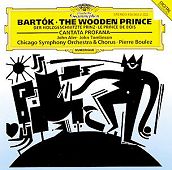John Aler; John Tomlinson; Orquesta Sinfónica y Coro de Chicago; Pierre Boulez.
Deutsche Grammophon 435863-2
[72'10"]

| Audioclásica |
El gran director francés grabó la mejor versión imaginable de este raro ballet y de la espiritual cantata, aunque la primera obra destaca especialmente por su compleja orquestación, que Boulez y la sinfónica de Chicago restituyen con una claridad de texturas increíble.
| Gramophone |
A disc to rank alongside other Chicago Bartók classics, such as Dorati's mono The miraculous mandarin Suite (Mercury, 2/55) and Reiner's Concerto for Orchestra and Music for Strings, Percussion and Celesta (RCA, 1/90). The reasons? Partly performance and recording, partly repertoire. The repertoire hook is Bartók's parable of fathers, sons and fleeing the nest, his 1930 Cantata profana, a mesmerizing, symmetrically designed masterpiece, where words and music are forged into an action-packed 18 minutes. Boulez provides what is by far the best studio recording the work has ever had (it's also the first in digital sound), more poetic, pungent and forceful than either Ferencsik (Hungaroton) or the old, English-language Susskind LP version (Bartók Recording Studio), and truly state-of-the-art in terms of sound. Boulez is able to command a shimmering hushed pp (try the tenors' first entry, 1'04" into the opening), yet the battle-hardy Allegro molto (3'30" in) with its hectoring syncopations and warlike percussion, is full of grit and muscle. John Aler is wonderfully adroit with Bartók's high-flying solo tenor line (although he can't quite match the sweet yet disquieting Jozsef Reti for Ferencsik); John Tomlinson sounds like an authentic Magyar, and the Chicago Symphony Chorus egg the proceedings on with tireless zeal.
Turn then to The Wooden Prince and you confront the final flowering of Bartók's post-romantic phase, it's an effulgent, exotic piece, full of wistful, melancholy wind solos (clarinet and saxophone figure prominently) and billowing, heavily-scored climaxes. How astonishing to reflect that it was written after the composer's trail-blazing opera, Bluebeard's Castle. Here Boulez prompts memories of his younger self (from 1975, to be exact �CBS, 3/89�) with the New York Philharmonic, but the newer version is both more genial and vastly better recorded. Again, the soft music is wonderfully atmospheric: the ppp muted violins in the Prelude have a ghostly pallor that is so typical of this orchestra's quiet string playing, yet when all are engaged at full throttle, the effect is shattering. Detail is legion throughout: the basses, brass and drums have immense presence (the «Dance of the Trees» issues an ominous growl), there's plenty of percussion glitter in the chirpy «Dance of the Princess with the wooden prince» and work's lyrical close is beautifully blended. Järvi and the Philharmonia (Chandos) are also very good, if rather more reverberantly recorded, perhaps Järvi is the more unbuttoned in the livelier dances, the less minutely observant of the waves and trees. However, it is Boulez who achieves the greater precision overall, and whose work receives the more impressive (and resonant) sound.
Järvi's Wooden prince is coupled with the pleasant if comparatively inconsequential Hungarian Sketches, a fair choice given his friendlier view of the main work. But Boulez's coupling is, as I have suggested, the best reason for rushing out andpurchasing his disc: it is an indisputable masterpiece, and one that should be in every self-respecting collection of twentieth-century musical landmarks. Why isn't it played and recorded more often?
|
|